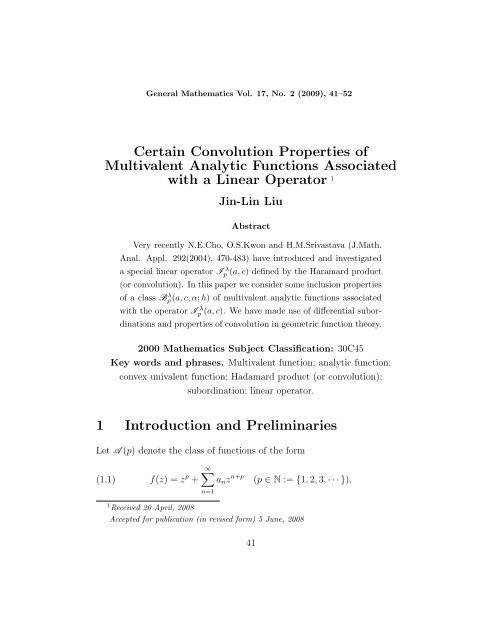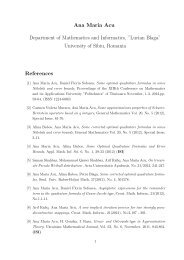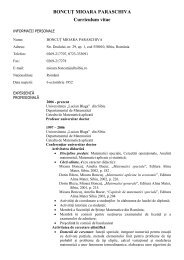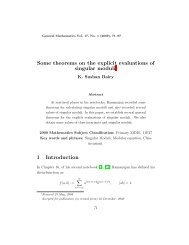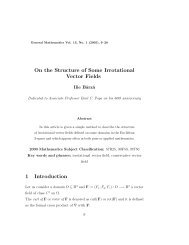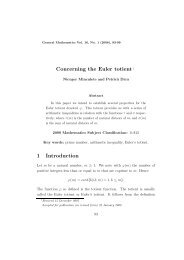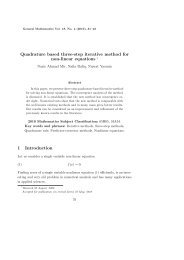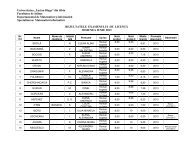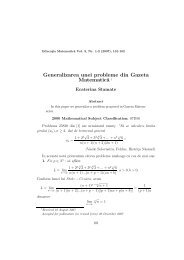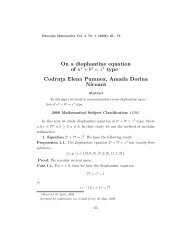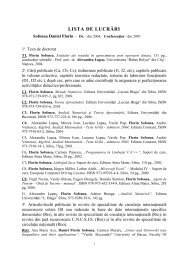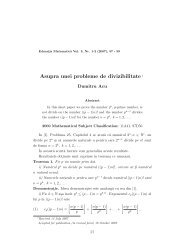Certain Convolution Properties of Multivalent Analytic Functions ...
Certain Convolution Properties of Multivalent Analytic Functions ...
Certain Convolution Properties of Multivalent Analytic Functions ...
You also want an ePaper? Increase the reach of your titles
YUMPU automatically turns print PDFs into web optimized ePapers that Google loves.
General Mathematics Vol. 17, No. 2 (2009), 41–52<br />
<strong>Certain</strong> <strong>Convolution</strong> <strong>Properties</strong> <strong>of</strong><br />
<strong>Multivalent</strong> <strong>Analytic</strong> <strong>Functions</strong> Associated<br />
with a Linear Operator 1<br />
Jin-Lin Liu<br />
Abstract<br />
Very recently N.E.Cho, O.S.Kwon and H.M.Srivastava (J.Math.<br />
Anal. Appl. 292(2004), 470-483) have introduced and investigated<br />
a special linear operator Ip λ (a, c) defined by the Haramard product<br />
(or convolution). In this paper we consider some inclusion properties<br />
<strong>of</strong> a class Bp λ (a, c, α; h) <strong>of</strong> multivalent analytic functions associated<br />
with the operator Ip λ (a, c). We have made use <strong>of</strong> differential subordinations<br />
and properties <strong>of</strong> convolution in geometric function theory.<br />
2000 Mathematics Subject Classification: 30C45<br />
Key words and phrases. <strong>Multivalent</strong> function; analytic function;<br />
convex univalent function; Hadamard product (or convolution);<br />
subordination; linear operator.<br />
1 Introduction and Preliminaries<br />
Let A (p) denote the class <strong>of</strong> functions <strong>of</strong> the form<br />
(1.1) f(z) = z p +<br />
∞∑<br />
a n z n+p (p ∈ N := {1, 2, 3, · · · }),<br />
n=1<br />
1 Received 20 April, 2008<br />
Accepted for publication (in revised form) 5 June, 2008<br />
41
42 Jin-Lin Liu<br />
which are analytic in the open unit disk U := {z : z ∈ C and |z| < 1}. Also<br />
let the Hadamard product (or convolution) <strong>of</strong> two functions<br />
f j (z) = z p +<br />
be given by<br />
(f 1 ∗ f 2 )(z) := z p +<br />
∞∑<br />
a n,j z n+p (j = 1, 2),<br />
n=1<br />
∞∑<br />
a n,1 a n,2 z n+p =: (f 2 ∗ f 1 )(z).<br />
n=1<br />
Given two functions f(z) and g(z), which are analytic in U, we say that<br />
the function g(z) is subordinate to f(z) and write g(z) ≺ f(z) (z ∈ U),<br />
if there exists a Schwarz function w(z), analytic in U with w(0) = 0 and<br />
|w(z)| < 1 (z ∈ U) such that g(z) = f(w(z)) (z ∈ U). In particular, if<br />
f(z) is univalent in U, we have the following equivalence<br />
g(z) ≺ f(z)<br />
(z ∈ U) ⇔ g(0) = f(0) and g(U) ⊂ f(U).<br />
A function f(z) ∈ A (1) is said to be in the class S ∗ (ρ) if<br />
{ } zf ′ (z)<br />
Re > ρ (z ∈ U)<br />
f(z)<br />
for some ρ(ρ < 1). When 0 ≤ ρ < 1, S ∗ (ρ) is the class <strong>of</strong> starlike functions<br />
<strong>of</strong> order ρ in U. A function f(z) ∈ A (1) is said to be prestarlike <strong>of</strong> order ρ<br />
in U if<br />
z<br />
(1 − z) 2(1−ρ) ∗ f(z) ∈ S ∗ (ρ) (ρ < 1).<br />
We note this class by R(ρ) (see [6]). Clearly a function f(z) ∈ A (1) is in<br />
the class R(0) if and only if f(z) is convex univalent in U and<br />
( ( )<br />
1 1<br />
R = S<br />
2)<br />
∗ .<br />
2<br />
In [7] Saitoh introduced a linear operator<br />
L p (a, c) : A (p) → A (p)
<strong>Certain</strong> <strong>Convolution</strong> <strong>Properties</strong> <strong>of</strong>... 43<br />
defined by<br />
(1.2) L p (a, c)f(z) := φ p (a, c; z) ∗ f(z) (z ∈ U; f ∈ A (p))<br />
where<br />
φ p (a, c; z) :=<br />
∞∑<br />
n=0<br />
(a) n<br />
(c) n<br />
z n+p<br />
(1.3) (a ∈ R, c ∈ R \ Z − 0 , Z − 0 := {0, −1, −2, · · · }; z ∈ U).<br />
and (x) n is the Pochhammer symbol defined by<br />
(x) n =<br />
{<br />
1 for n = 0,<br />
x(x + 1) · · · (x + n − 1) for n ∈ N.<br />
The operator L p (a, c) is an extension <strong>of</strong> the Carlson-Shaffer operator [1].<br />
Very recently, Cho, Kwon and Srivastava [2] introduced the following linear<br />
operator I λ<br />
p (a, c) analogous to L p (a, c):<br />
I λ<br />
p (a, c) : A (p) → A (p)<br />
I λ<br />
p (a, c)f(z) := φ † p(a, c; z) ∗ f(z)<br />
(1.4) (a, c ∈ R \ Z − 0 , λ > −p ; z ∈ U; f ∈ A (p)),<br />
where φ † p(a, c; z) is the function defined in terms <strong>of</strong> the Hadamard product<br />
(or convolution) by the following condition<br />
(1.5) φ p (a, c; z) ∗ φ † p(a, c; z) =<br />
z p<br />
(1 − z) λ+p ,<br />
where φ p (a, c; z) is given by (1.3). It is well known that for λ > −p<br />
(1.6)<br />
z p<br />
(1 − z) = ∑ ∞ λ+p<br />
n=0<br />
(λ + p) n<br />
z n+p<br />
n!<br />
(z ∈ U).
44 Jin-Lin Liu<br />
Therefore the function φ † p(a, c; z) has the following form<br />
(1.7) φ † p(a, c; z) =<br />
∞∑<br />
n=0<br />
(λ + p) n (c) n<br />
n!(a) n<br />
z n+p (z ∈ U).<br />
Cho, Kwon and Srivastava [2] have obtained the following properties <strong>of</strong> the<br />
operator I λ<br />
p (a, c) :<br />
(1.8) Ip 1 (p + 1, 1)f(z) = f(z), Ip 1 (p, 1)f(z) = zf ′ (z)<br />
,<br />
p<br />
(1.9) z(I λ<br />
p (a + 1, c)f(z)) ′ = aI λ<br />
p (a, c)f(z) − (a − p)I λ<br />
p (a + 1, c)f(z),<br />
and<br />
(1.10) z(Ip λ (a, c)f(z)) ′ = (λ + p)Ip<br />
λ+1 (a, c)f(z) − λIp λ (a, c)f(z).<br />
Many interesting results <strong>of</strong> multivalent analytic functions associated with<br />
the linear operator I λ<br />
p (a, c) have been given in [2]. Also, the authors [2]<br />
presented a long list <strong>of</strong> papers connected with the operators (1.2) and (1.4)<br />
and classes <strong>of</strong> functions defined by means <strong>of</strong> those operators.<br />
Let P be the class <strong>of</strong> functions h(z) with h(0) = 1, which are analytic<br />
and convex univalent in U.<br />
In this paper, we shall introduce and investigate the following subclass<br />
<strong>of</strong> A (p) associated with the operator I λ<br />
p (a, c).<br />
Definition 1. A function f(z) ∈ A (p) is said to be in the class B λ p (a, c, α; h)<br />
if it satisfies the subordination condition<br />
(1.11) (1 − α)z −p I λ<br />
p (a, c)f(z) + α p z−p+1 (I λ<br />
p (a, c)f(z)) ′ ≺ h(z),<br />
where α is a complex number, a, c ∈ R \ Z − 0 and h(z) ∈ P.<br />
The following lemmas will be used in our investigation.
<strong>Certain</strong> <strong>Convolution</strong> <strong>Properties</strong> <strong>of</strong>... 45<br />
Lemma 1. (see [4,5]) Let g(z) be analytic in U and h(z) be analytic and<br />
convex univalent in U with h(0) = g(0). If<br />
(1.12) g(z) + 1 µ zg′ (z) ≺ h(z),<br />
where Reµ ≥ 0 and µ ≠ 0, then g(z) ≺ h(z).<br />
Lemma 2. (see [6]) Let ρ < 1, f(z) ∈ S ∗ (ρ) and g(z) ∈ R(ρ). Then, for<br />
any analytic function F (z) in U,<br />
g ∗ (fF )<br />
(U) ⊂ co(F (U)),<br />
g ∗ f<br />
where co(F (U)) denotes the closed convex hull <strong>of</strong> F (U).<br />
2 Inclusion <strong>Properties</strong> Involving the Operator<br />
I λ<br />
p (a, c)<br />
Theorem 1. Let 0 ≤ α 1 < α 2 . Then<br />
B λ p (a, c, α 2 ; h) ⊂ B λ p (a, c, α 1 ; h).<br />
Pro<strong>of</strong>. Let 0 ≤ α 1 < α 2 and suppose that<br />
(2.1) g(z) = z −p I λ<br />
p (a, c)f(z)<br />
for f(z) ∈ B λ p (a, c, α 2 ; h).<br />
Then the function g(z) is analytic in U with<br />
g(0) = 1. Differentiating both sides <strong>of</strong> (2.1) with respect to z and using<br />
(1.11), we have<br />
(2.2)<br />
(1 − α 2 )z −p I λ<br />
p (a, c)f(z) + α 2<br />
p z−p+1 (I λ<br />
p (a, c)f(z)) ′<br />
= g(z) + α 2<br />
p zg′ (z) ≺ h(z).
46 Jin-Lin Liu<br />
Hence an application <strong>of</strong> Lemma 1 yields<br />
(2.3) g(z) ≺ h(z).<br />
Noting that 0 ≤ α 1<br />
α 2<br />
< 1 and that h(z) is convex univalent in U, it follows<br />
from (2.1), (2.2) and (2.3) that<br />
(1 − α 1 )z −p Ip λ (a, c)f(z) + α 1<br />
p z−p+1 (Ip λ (a, c)f(z)) ′<br />
= α (<br />
1<br />
(1 − α 2 )z −p Ip λ (a, c)f(z) + α )<br />
2<br />
α 2 p z−p+1 (Ip λ (a, c)f(z)) ′ +<br />
≺ h(z).<br />
Thus f(z) ∈ B λ p (a, c, α 1 ; h) and the pro<strong>of</strong> <strong>of</strong> Theorem 1 is completed.<br />
Theorem 2. Let<br />
(<br />
1 − α )<br />
1<br />
g(z)<br />
α 2<br />
(2.4) Re{z −p φ p (a 1 , a 2 ; z)} > 1 2<br />
(z ∈ U),<br />
where φ p (a 1 , a 2 ; z) is defined as in (1.3). Then<br />
B λ p (a 1 , c, α; h) ⊂ B λ p (a 2 , c, α; h).<br />
Pro<strong>of</strong>. For f(z) ∈ A (p) it is easy to verify that<br />
(2.5) z −p I λ<br />
p (a 2 , c)f(z) = (z −p φ p (a 1 , a 2 ; z)) ∗ (z −p I λ<br />
p (a 1 , c)f(z))<br />
and<br />
(2.6) z −p+1 (I λ<br />
p (a 2 , c)f(z)) ′ = (z −p φ p (a 1 , a 2 ; z)) ∗ (z −p+1 (I λ<br />
p (a 1 , c)f(z)) ′ ).<br />
Let f(z) ∈ B λ p (a 1 , c, α; h). Then from (2.5) and (2.6) we deduce that<br />
(2.7)<br />
(1 − α)z −p I λ<br />
p (a 2 , c)f(z) + α p z−p+1 (I λ<br />
p (a 2 , c)f(z)) ′<br />
= (z −p φ p (a 1 , a 2 ; z)) ∗ ψ(z)
<strong>Certain</strong> <strong>Convolution</strong> <strong>Properties</strong> <strong>of</strong>... 47<br />
and<br />
(2.8)<br />
ψ(z) = (1 − α)z −p I λ<br />
p (a 1 , c)f(z) + α p z−p+1 (I λ<br />
p (a 1 , c)f(z)) ′<br />
≺ h(z).<br />
In view <strong>of</strong> (2.4), the function z −p φ p (a 1 , a 2 ; z) has the Herglotz representation<br />
∫<br />
(2.9) z −p dµ(x)<br />
φ p (a 1 , a 2 ; z) =<br />
(z ∈ U),<br />
1 − xz<br />
|x|=1<br />
where µ(x) is a probability measure defined on the unit circle |x| = 1 and<br />
∫<br />
dµ(x) = 1.<br />
|x|=1<br />
Since h(z) is convex univalent in U, it follows from (2.7), (2.8) and (2.9)<br />
that<br />
(1 − α)z −p Ip λ (a 2 , c)f(z) + α p z−p+1 (Ip λ (a 2 , c)f(z)) ′<br />
∫<br />
= ψ(xz)dµ(x) ≺ h(z).<br />
|x|=1<br />
This shows that f(z) ∈ B λ p (a 2 , c, α; h).<br />
Theorem 3. Let<br />
(2.10) Re{z −p φ p (c 1 , c 2 ; z)} > 1 2<br />
(z ∈ U),<br />
where φ p (c 1 , c 2 ; z) is defined as in (1.3). Then<br />
B λ p (a, c 2 , α; h) ⊂ B λ p (a, c 1 , α; h).<br />
Pro<strong>of</strong>. For f(z) ∈ A (p) it is easy to verify that<br />
and<br />
z −p I λ<br />
p (a, c 1 )f(z) = (z −p φ p (c 1 , c 2 ; z)) ∗ (z −p I λ<br />
p (a, c 2 )f(z))<br />
z −p+1 (I λ<br />
p (a, c 1 )f(z)) ′ = (z −p φ p (c 1 , c 2 ; z)) ∗ (z −p+1 (I λ<br />
p (a, c 2 )f(z)) ′ ).<br />
The remaining part <strong>of</strong> the pro<strong>of</strong> <strong>of</strong> Theorem 3 is similar to that <strong>of</strong><br />
Theorem 2 and hence we omit it.
48 Jin-Lin Liu<br />
Theorem 4. Let 0 < a 1 < a 2 . Then<br />
Pro<strong>of</strong>. Define<br />
Then<br />
g(z) = z +<br />
B λ p (a 1 , c, α; h) ⊂ B λ p (a 2 , c, α; h).<br />
∞∑<br />
n=1<br />
(a 1 ) n<br />
(a 2 ) n<br />
z n+1 (z ∈ U; 0 < a 1 < a 2 ).<br />
(2.11) z −p+1 φ p (a 1 , a 2 ; z) = g(z) ∈ A (1),<br />
where φ p (a 1 , a 2 ; z) is defined as in (1.3), and<br />
z<br />
(2.12)<br />
(1 − z) ∗ g(z) = z<br />
a 2 (1 − z) . a 1<br />
By (2.12) we see that<br />
z<br />
(<br />
(1 − z) ∗ g(z) ∈ S ∗ 1 − a 1<br />
a 2 2<br />
for 0 < a 1 < a 2 which shows that<br />
(<br />
(2.13) g(z) ∈ R<br />
1 − a 2<br />
2<br />
)<br />
⊂ S ∗ (<br />
1 − a 2<br />
2<br />
Let f(z) ∈ B λ p (a 1 , c, α; h). Then we deduce from (2.7) and (2.8) (used<br />
in the pro<strong>of</strong> <strong>of</strong> Theorem 2) and (2.11) that<br />
)<br />
.<br />
)<br />
(2.14)<br />
where<br />
(1 − α)z −p I λ<br />
p (a 2 , c)f(z) + α p z−p+1 (I λ<br />
p (a 2 , c)f(z)) ′<br />
= g(z)<br />
z<br />
∗ ψ(z) =<br />
g(z) ∗ (zψ(z))<br />
,<br />
g(z) ∗ z<br />
(2.15) ψ(z) = (1 − α)z −p I λ<br />
p (a 1 , c)f(z) + α p z−p+1 (I λ<br />
p (a 1 , c)f(z)) ′ .<br />
Since the function z belongs to S ∗ ( 1 − a 2<br />
2<br />
)<br />
and h(z) is convex univalent in<br />
U, it follows from (2.13), (2.14), (2.15) and Lemma 2 that<br />
(1 − α)z −p I λ<br />
p (a 2 , c)f(z) + α p z−p+1 (I λ<br />
p (a 2 , c)f(z)) ′ ≺ h(z).<br />
Thus f(z) ∈ B λ p (a 2 , c, α; h) and the pro<strong>of</strong> is completed.
<strong>Certain</strong> <strong>Convolution</strong> <strong>Properties</strong> <strong>of</strong>... 49<br />
Theorem 5. Let 0 < c 1 < c 2 . Then<br />
B λ p (a, c 2 , α; h) ⊂ B λ p (a, c 1 , α; h).<br />
Pro<strong>of</strong>. Define<br />
g(z) = z +<br />
∞∑<br />
n=1<br />
(c 1 ) n<br />
(c 2 ) n<br />
z n+1 (z ∈ U; 0 < c 1 < c 2 ).<br />
Then<br />
z −p+1 φ p (c 1 , c 2 ; z) = g(z) ∈ A (1),<br />
where φ p (c 1 , c 2 ; z) is defined as in (1.3), and<br />
(2.16)<br />
z<br />
(1 − z) ∗ g(z) = z<br />
c 2 (1 − z) . c 1<br />
From (2.16) we see that<br />
z<br />
(<br />
(1 − z) ∗ g(z) ∈ S ∗ 1 − c 1<br />
c 2 2<br />
for 0 < c 1 < c 2 which shows that<br />
(<br />
g(z) ∈ R<br />
1 − c 2<br />
2<br />
)<br />
⊂ S ∗ (<br />
1 − c 2<br />
2<br />
The remaining part <strong>of</strong> the pro<strong>of</strong> is similar to that <strong>of</strong> Theorem 4 and we<br />
omit it.<br />
Theorem 6. Let f(z) ∈ B λ p (a, c, α; h),<br />
)<br />
.<br />
)<br />
(2.17) g(z) ∈ A (p) and Re{z −p g(z)} > 1 2<br />
(z ∈ U).<br />
Then<br />
(f ∗ g)(z) ∈ B λ p (a, c, α; h).
50 Jin-Lin Liu<br />
Pro<strong>of</strong>. For f(z) ∈ B λ p (a, c, α; h) and g(z) ∈ A (p), we have<br />
(1 − α)z −p I λ<br />
p (a, c)(f ∗ g)(z) + α p z−p+1 (I λ<br />
p (a, c)(f ∗ g)(z)) ′<br />
= (1 − α)(z −p g(z)) ∗ (z −p I λ<br />
p (a, c)f(z)) + α p (z−p g(z)) ∗ (z −p+1 (I λ<br />
p (a, c)f(z)) ′ )<br />
(2.18)<br />
= (z −p g(z)) ∗ ψ(z),<br />
where<br />
(2.19) ψ(z) = (1 − α)z −p I λ<br />
p (a, c)f(z) + α p z−p+1 (I λ<br />
p (a, c)f(z)) ′ ≺ h(z).<br />
In view <strong>of</strong> (2.17), the function z −p g(z) has the Herglotz representation<br />
∫<br />
(2.20) z −p g(z) =<br />
|x|=1<br />
dµ(x)<br />
1 − xz<br />
(z ∈ U),<br />
where µ(x) is a probability measure defined on the unit circle |x| = 1 and<br />
∫<br />
dµ(x) = 1.<br />
|x|=1<br />
Since h(z) is convex univalent in U, it follows from (2.18) to (2.20) that<br />
(1 − α)z −p Ip λ (a, c)(f ∗ g)(z) + α p z−p+1 (Ip λ (a, c)(f ∗ g)(z)) ′<br />
∫<br />
= ψ(xz)dµ(x) ≺ h(z).<br />
|x|=1<br />
This shows that (f ∗ g)(z) ∈ B λ p (a, c, α; h) and the theorem is proved.<br />
Theorem 7. Let f(z) ∈ B λ p (a, c, α; h),<br />
g(z) ∈ A (p) and z −p+1 g(z) ∈ R(ρ) (ρ < 1).<br />
Then<br />
(f ∗ g)(z) ∈ B λ p (a, c, α; h).
<strong>Certain</strong> <strong>Convolution</strong> <strong>Properties</strong> <strong>of</strong>... 51<br />
Pro<strong>of</strong>. For f(z) ∈ B λ p (a, c, α; h) and g(z) ∈ A (p), from (2.18) we can write<br />
(2.21)<br />
(1 − α)z −p I λ<br />
p (a, c)(f ∗ g)(z) + α p z−p+1 (I λ<br />
p (a, c)(f ∗ g)(z)) ′<br />
= (z−p+1 g(z)) ∗ (zψ(z))<br />
(z −p+1 g(z)) ∗ z<br />
(z ∈ U),<br />
where ψ(z) is defined as in (2.19).<br />
Since h(z) is convex univalent in U,<br />
ψ(z) ≺ h(z), z −p+1 g(z) ∈ R(ρ) and z ∈ S ∗ (ρ) (ρ < 1),<br />
it follows from (2.21) and Lemma 2 the desired result.<br />
References<br />
[1] B.C.Carlson, D.B.Shaffer, Starlike and prestarlike hypergeometric functions,<br />
SIAM J.Math.Anal. 15(1984), 737-745.<br />
[2] N.E.Cho, O.S.Kwon, H.M.Srivastava, Inclusion relationships and argument<br />
properties for certain subclasses <strong>of</strong> multivalent functions associated<br />
with a family <strong>of</strong> linear operators, J.Math.Anal.Appl. 292(2004),<br />
470-483.<br />
[3] J.Dziok, H.M.Srivastava, Classes <strong>of</strong> analytic functions associated<br />
with the generalized hypergeometric function, Appl.Math.Comput.<br />
103(1999), 1-13.<br />
[4] D.J.Hallenbeck, S.Ruscheweyh, Subordination by convex functions,<br />
Proc.Amer.Math.Soc. 52(1975), 191-195.<br />
[5] S.S.Miller, P.T.Mocanu, Differential subordinations and univalent functions,<br />
Michigan Math.J. 28(1981), 157-171.
52 Jin-Lin Liu<br />
[6] S.Ruscheweyh, <strong>Convolution</strong>s in Geometric Function Theory, Les<br />
Presses de 1’Université de Montréal, Montréal, 1982.<br />
[7] H.Saitoh, A linear operator and its applications <strong>of</strong> first order differential<br />
subordinations, Math.Japon. 44(1996), 31-38.<br />
[8] J.Sokol, L.T.Spelina, <strong>Convolution</strong> properties for certain classes <strong>of</strong> multivalent<br />
functions, J.Math.Anal.Appl., in press.<br />
Department <strong>of</strong> Mathematics,<br />
Yangzhou University<br />
Yangzhou 225002, Jiangsu, P.R.China<br />
E-mail: jlliu@yzu.edu.cn


